
Podocnemididae is a family of pleurodire turtles native to Madagascar and northern South America. Podocnemidid turtles are commonly called "side-necked turtles" in direct reference to their inability to retract their heads backwards, but hide them sideways. In addition, their pelvis is fused to the shell which prevents any pelvic motion. Due to their pelvis being immobile they are unable to walk on land, which requires greater pelvis mobility. For this reason, Podocnemididae turtles are best suited for swimming and as a result live in aquatic environments. These turtles are all aquatic, inhabiting streams and other flowing water. Their shells are streamlined to aid in swimming.
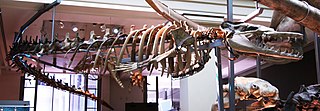
Basilosaurus is a genus of large, predatory, prehistoric archaeocete whale from the late Eocene, approximately 41.3 to 33.9 million years ago (mya). First described in 1834, it was the first archaeocete and prehistoric whale known to science. The first fossils were discovered along the Gulf Coast of the United States, along with a few fossils in the eastern U.S., attributed to the type species B. cetoides. They were originally thought to be of a giant reptile, hence the suffix "-saurus", Ancient Greek for "lizard". The animal was later found to be an early marine mammal, which prompted attempts at renaming the creature, which failed as zoological nomenclature dictates using the original name given. Fossils were later found of the second species, B. isis, in 1904 in North Africa, more specifically the countries of Egypt, Jordan, Tunisia and Morocco. Basilosaurus has a possible record in Seymour Island in Antarctica.

Basilosauridae is a paraphyletic family of extinct cetaceans. They lived during the middle to the early late Eocene and are known from all continents, including Antarctica. They were probably the first fully aquatic cetaceans.

Wadi Al-Hitan is a paleontological site in the Faiyum Governorate of Egypt, some 150 kilometres (93 mi) south-west of Cairo. It was designated a UNESCO World Heritage Site in July 2005 for its hundreds of fossils of some of the earliest forms of whale, the archaeoceti. The site reveals evidence for the explanation of one of the greatest mysteries of the evolution of whales: the emergence of the whale as an ocean-going mammal from a previous life as a land-based animal. No other place in the world yields the number, concentration and quality of such fossils, as is their accessibility and setting in an attractive and protected landscape. This is why it was added by the UNESCO to the list of protected World Heritage Sites.
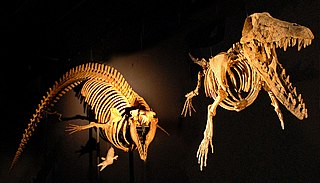
Archaeoceti, or Zeuglodontes in older literature, is a paraphyletic group of primitive cetaceans that lived from the Early Eocene to the late Oligocene. Representing the earliest cetacean radiation, they include the initial amphibious stages in cetacean evolution, thus are the ancestors of both modern cetacean suborders, Mysticeti and Odontoceti. This initial diversification occurred in the shallow waters that separated India and Asia 53 to 45 mya, resulting in some 30 species adapted to a fully oceanic life; though both echolocation and filter-feeding evolved during a second radiation 36 to 35 mya.

Pycnodus is an extinct genus of ray-finned fish ranging from the Jurassic to Eocene periods. As its name suggests, it is the type genus of Pycnodontiformes.
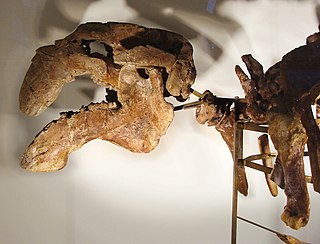
Eotheroides is an extinct genus of Eocene sirenian. It is an early member of the family Dugongidae, which includes the extant dugong. Fossils have been found from Egypt, India, and Madagascar. Eotheroides was first described by Richard Owen in 1875 under the name Eotherium, which was replaced by the current name in 1899.

Protosiren is an extinct early genus of the order Sirenia. Protosiren existed throughout the Lutetian to Priabonian stages of the Middle Eocene. Fossils have been found in the far-flung locations like the United States, Africa (Egypt), Europe and Asia.
Maroccosuchus zennaroi is an extinct tomistomine crocodylian from the early Eocene of Morocco. A recent phylogenetic assessment of Tomistoninae determined that M. zennaroi is the basalmost tomistomine.
Paratomistoma is an extinct genus of tomistomine crocodylian. It is based on the holotype specimen CGM 42188, a partial posterior skull and lower jaw discovered at Wadi Hitan, Egypt, in Middle Eocene-age rocks of the Gehannam Formation. The skull is unfused but considered morphologically mature. Paratomistoma was named in 2000 by Christopher Brochu and Philip Gingerich; the type species is P. courti in honor of Nicholas Court, who found CGM 42188. They performed a phylogenetic analysis and found Paratomistoma to be a derived tomistomine. It may have been a marine or coastal crocodilian.
Ancalecetus is an extinct genus of early whale known from the Late Eocene Birket Qarun Formation in Wadi Al-Hitan, Egypt. The species is named after anthropologist and primate researcher Elwyn L. Simons who discovered the type specimen in 1985.
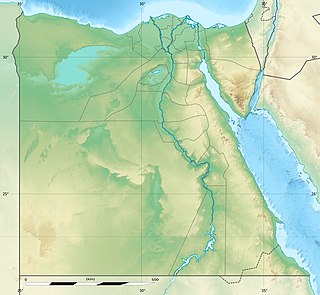
The Qasr el Sagha Formationis a geological formation located in Egypt The formation is part of the Wadi El Hitan World Heritage Site. The Qasr el Sagha Formation overlies the Birket Qarun Formation and is overlain by the Gebel Qatrani Formation. The sandstones and shales of the formation were deposited in a deltaic to shallow marine environment. It dates to the Late Eocene.

Wadi El Rayan is a unique nature protectorate in Faiyum Governorate, Egypt, under the supervision of the Ministry of Environmental Affairs (EEAA).
Protocetidae, the protocetids, form a diverse and heterogeneous group of extinct cetaceans known from Asia, Europe, Africa, South America, and North America.
Egypt has many fossil-bearing geologic formations, in which many dinosaurs have been discovered.
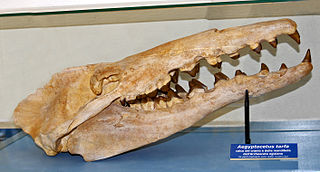
Aegyptocetus is an extinct genus of protocetid archaeocete whale known from Egypt.

The Washakie Formation is a geologic formation in northern Colorado and southern Wyoming. It preserves many mammal, bird, reptile and other fossils dating back to the Lutetian stage of the Eocene within the Paleogene period. The sediments fall in the Bridgerian and Uintan stages of the NALMA classification.
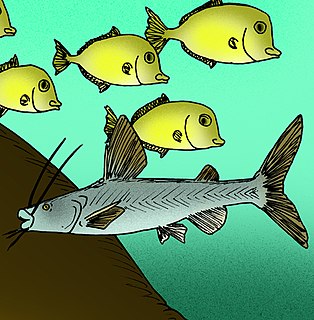
Qarmoutus hitanensis is an extinct ariid catfish whose fossils were first discovered in Wadi Al-Hitan, Egypt. It lived during the Eocene period around 37 million years ago, and its body length is estimated to be about 6.5 feet long.

Aegicetus is an extinct genus of protocetid whale based on a partial skull with much of an associated postcranial skeleton discovered in Egypt. It lived around 35 million years ago, making it the youngest known protocetid to date. Aegicetus was discovered in 2007 at Wadi El Hitan as a relatively complete skeleton and a partial second specimen. They were assigned to a new genus and species in 2019 by Philip D. Gingerich et al.













